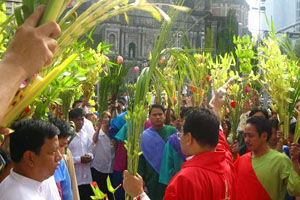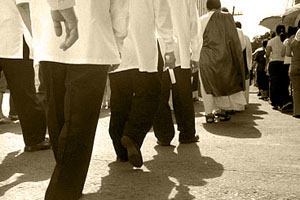Holy Week is a season of sacrifices and repentance. For some, it is their time to have that well-deserved rest from workloads and other stressful endeavors. Holy Week, Mahal na Araw, or Semana Santa, however you want to call it, is still a much celebrated season for Filipino Catholics.
Palm Sunday
Catholics bring palaspas (or palm leaves) to church for the Palm Sunday mass. The priest would bless these palm leaves and the churchgoers will bring them back to their house and place them either on their windows or above the front door, believing this would drive bad spirits away. Years back, my dad would make our own palaspas until vendors came up with beautiful designs out of strands of palm leaves. It’s instant palaspas right in every church’s facade.

Pabasa
From articles I have read, Pabasa (reading or chanting of Pasyon) starts on Holy Monday and would last for about two days. Pasyon is a narrative of Christ’s passion, death and resurrection. But here in Batangas, there are some who does this Pabasa as early as a month before the Holy Week. I’ve never experienced chanting the Pasyon (or even reading it). My mom reads it every night, silently though.

Bisita Iglesia
Batangas is one of the frequented destinations for Bisita Iglesia because of the province’s numerous churches. In the tradition, it is done on Maundy Thursday. Among the famous churches for Bisita Iglesia are San Sebastian Cathedral in Lipa City, Basilica of St. Martin de Tours in Taal, Mt. Carmel Church also in Lipa City. Click here for more churches. This Holy Week activity is one that I’m very fond of doing. It’s not a usual thing to pray in nine churches for one day. Aside from that, I get to explore religious spots in the province that I have never been to. Doing this church visit is also a great chance for family members to strengthen our bond as we pray together.

The Washing of the Feet is also done on Maundy Thursday, in the last mass before Easter Sunday. This is a reenactment of Christ’s washing of His Apostles’ feet.
The Good Friday
On Good Friday, people gather together for the commemoration of Christ’s Seven Last Words (or Siete Palabras). Here in our place, a huge street procession is done around five o’clock in the afternoon. The family of my dad’s close pal owns an image of Saint Veronica which is included in the procession. My dad and his friend are always the ones in charge of arranging the karosa and pulling it during the procession. My mom and I have joined the two for the past three years, making it our own little sacrifice for the Lenten season.

A Happy Easter
After a quiet Black Saturday, Catholics are preparing for the celebration of Christ’s resurrection. At the dawn of the Easter Sunday, large statues of Jesus and the Virgin Mary will be out on the street for the procession called Salubong (or ‘meeting’). Here in Batangas, a tradition called dagit highlights the Salubong. Dagit a Tagalog term meaning to catch or to hook something. A child would hook the black veil off the head of the Virgin Mary which signifies that her mourning is over for her Son has already risen.

It’s a happy Sunday for everyone as Catholic faithfuls join together for the Easter mass. When I was little, our family used to have our own Easter egg hunt. Today, this is a famous mall activity for kids.
This is how Holy Week is like here in Batangas or all over the Philippines. There are still other Holy Week traditions in some parts of the country that I have not mentioned. These Holy week activities are done by people as their ‘panata’, as their sacrifices. How we glorify God does not begin nor end in Holy week. It’s a lifetime selfless act we should keep within us.
[tags]holy week in the philippines, holy week in batangas, holy week traditions philippines, holy week activities in the philippines, what to do in holy week, semana santa, mahal na araw, bisita iglesia in batangas, filipino holy week, how to spend holy week in the philippines, holy week pabasa, pasyon, salubong, dagit, what is palaspas, batangas churches[/tags] WOWBatangas.com Your Source of Great News and Stories from the Province of Batangas, Philippines
WOWBatangas.com Your Source of Great News and Stories from the Province of Batangas, Philippines




One comment
Pingback: Culture/Traditions in Batangas – Culture/Tradition in Batangas